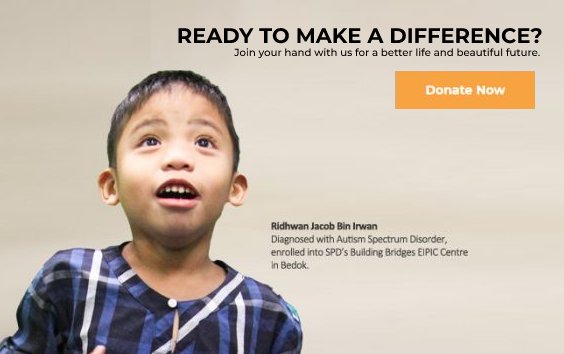Singapore, 28 November 2008 – For most, locating an ATM machine is the simple solution when one runs out of cash, but for wheelchair users like Julian Wee, the situation can be a logistical nightmare.
Most ATMs are built at a height such that users of conventional wheelchairs have difficulty reaching, much less reading the instructions that appear on the screen. Those within reach don’t offer any protection from prying eyes since wheelchair users can’t block others from seeing what’s on the screen. Some ATMs come built with a protective screen which offers greater security for non-disabled users, yet poses a barrier for wheelchair users who are unable to enter the narrow space between the screen and the ATM.
To avoid such problems, Julian takes special care to ensure that he has enough money in his wallet each time he leaves his house. When he does run out of cash, he would have to try to find a friend to borrow from, and who won’t mind his returning the money later by Internet transfer.
This is just one problem with physical access wheelchair-users grapple with daily among others. For a wheelchair user, a simple outing could require advanced planning, and still involve multiple backtracking and detouring to avoid kerbs, uneven pathways and stairs.
This is the situation today despite Prime Minister Lee Hsien Loong’s 2004 call for Singapore to be a more inclusive society. Physical, social (exclusion from social interactions and activities) and mental barriers stand in the way of the inclusion of disabled people.
The public is not unaware of the barriers against people with disabilities. In an informal survey on public transport conducted earlier in the year by students from Hwa Chong Junior College, 80% of the respondents thought it was inconvenient for wheelchair users to take public transport during peak hours, and 60% did not think that the existing transport facilities are accessible for wheelchair users. More than 50% thought that wheelchair users faced inconsiderate commuters when travelling.
In a street trial, the surveyors found that in 11 of the 38 trips made on the MRT during peak hours, there were commuters who showed displeasure when boarding a cabin with a wheelchair-user in it.
This is in contrast with a separate survey of 500 people by students from Ngee Ann Polytechnic’s (NP) School of Business & Accountancy. Of the respondents, about 90% said they would accept people with disabilities as friends and colleagues.
Conducted from July to September 2008, NP’s survey was designed to help the Society for the Physically Disabled (SPD) better understand the public’s views of people with physical disabilities.
“It could be a case of ‘acceptance only if it doesn’t inconvenience me, or interfere with my daily routine or needs’,” said Dr Ow Chee Chung, Executive Director, Society for the Physically Disabled. “”People with disabilities deserve the same regard and opportunities as everyone else, be it in social interactions, joining in activities in the community, schools and the workplace, and being able to get from one place to another. The public has been gradually coming to accept having people with disabilities in their midst, but more can be done to help integrate people with disabilities into mainstream society.”
To increase understanding, acceptance and inclusion of people with disabilities, SPD is commissioning a five-part info-educational series that will focus on the lives of and challenges faced by people with disabilities. ‘亮点人生 真情无障碍’ or ‘Breaking Barriers, Unlocking Potentials’ is done in conjunction with International Day of Persons with Disabilities and will be aired every Saturday from 29 November 2008 over Channel 8 at 9pm to 9.30pm. Hosted by Guo Liang, it will feature a few people with disabilities, the challenges they face and how they have or are working to overcome these, as well as the services available to help them.
“Efforts like ‘亮点人生 真情无障碍’ and other campaigns show that in many ways, people with disabilities are like everyone else. I hope the public will come to see that people with disabilities are a part of our society, so that one day soon it will be a norm more than an exception to see people with disabilities actively involved and contributing in Singapore,” says Julian.

